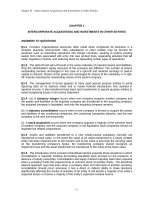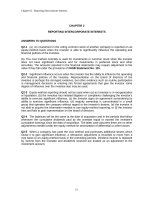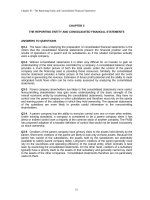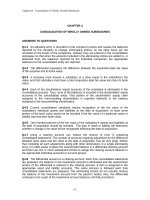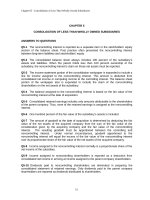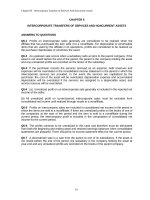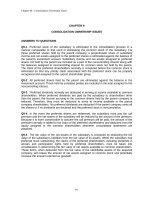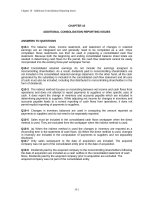Solution manual advanced financial accounting, 8th edition by baker chap011
Bạn đang xem bản rút gọn của tài liệu. Xem và tải ngay bản đầy đủ của tài liệu tại đây (226.16 KB, 78 trang )
Chapter 11 - Multinational Accounting: Foreign Currency Transactions And Financial Instruments
CHAPTER 11
MULTINATIONAL ACCOUNTING: FOREIGN CURRENCY TRANSACTIONS AND
FINANCIAL INSTRUMENTS
ANSWERS TO QUESTIONS
Q11-1 Indirect and direct exchange rates differ by which currency is desired to be
expressed in another currency. An indirect exchange rate is the number of foreign
currency units that may be obtained for one local currency unit. The indirect exchange
rate has the foreign currency unit in the numerator. As a fraction, the indirect
exchange rate is expressed as follows:
Number of foreign currency units
One local currency unit
A direct exchange rate is the number of local currency units needed to acquire one
foreign currency unit. The direct exchange rate has the local currency units in the
numerator (the U.S. dollar for the direct exchange rate for the U.S. dollar). As a
fraction, the direct exchange rate is expressed as follows:
Number of local currency units
One foreign currency unit
The indirect and direct exchange rates are inversely related and both state the same
relationship between two currencies.
Q11-2 The direct exchange rate can be calculated by taking the inverse of the
indirect exchange rate. Such a computation follows:
Number of foreign currency units
One local currency unit
=
C$1.3623 (Canadian dollars)
$1.00 (U.S. dollars)
The inverse of the indirect exchange rate is:
$1.00 (U.S. dollars)
C$1.36 (Canadian dollars)
=
$0.7340
Q11-3 When the U.S. dollar strengthens against the European euro, imports from
Europe into the U.S. will be less expensive in U.S. dollars. The direct exchange rate
decreases, indicating that it takes fewer dollars to acquire European euros.
11-1
Chapter 11 - Multinational Accounting: Foreign Currency Transactions And Financial Instruments
Q11-4 A foreign transaction is a transaction that does not involve the exchange of
currencies on the part of the reporting entity. An example of a foreign transaction is
the sale of equipment by a U.S. company (the reporting entity) to a Japanese firm
that is denominated in U.S. dollars.
A foreign currency transaction is a transaction that does involve the exchange of
currencies on the part of the reporting entity. An example of a foreign currency
transaction is the sale of equipment by a U.S. company (the reporting entity) to a
Japanese firm that is denominated in Japanese yen.
Q11-5 There are many types of economic factors that affect currency exchange
rates, among which are the level of inflation, the balance of payments, changes in
interest rates and investment levels, and the stability and process of governance.
One example of an economic factor that results in a weakening of the U.S. dollar
versus the European euro is a higher level of inflation in the U.S. relative to the
inflation in Europe.
Q11-6 Assets and liabilities denominated in a foreign currency are measured
according to the requirements in FASB 52 for those arising from normal purchase
and sale transactions, and by FASB 133 for forward exchange contracts and hedging
activities. FASB 52 specifies that the valuation at the transaction date and each
subsequent balance sheet date should be at the local currency equivalent using the
spot rate of exchange. Forward exchange contracts are valued at fair value, typically
by using the forward rate for the remainder of the term of the forward contract.
Q11-7 Foreign currency transaction gains or losses are recognized in the financial
statements in the period in which the exchange rate changes. These gains or losses
are reported on the income statement.
Q11-8 If the direct exchange rate increases, the Sun Company will experience a
foreign currency transaction loss on its $200,000 account payable that is
denominated in Canadian dollars. The increase in the direct exchange rate shows
that the U.S. dollar has weakened relative to the Canadian dollar, requiring more U.S.
dollars be used to pay the debt owed.
Q11-9 Four ways a U.S. company can manage the risk of changes in the exchange
rates for foreign currencies are to (1) use a forward contract to offset an exposed
foreign currency position, (2) hedge a firm foreign currency commitment as a fair
value hedge, (3) hedge an anticipated foreign transaction as a cash flow hedge, or (4)
speculate in foreign currency markets. One example of a U.S. company hedging
against the risk of changes in the exchange rates for foreign currencies is to use a
forward exchange receivable contract to partially offset the effects of changes in the
exchange rates of the foreign currency liability.
Q11-10 An exposed net asset position occurs when a company's trade receivables
and other assets denominated in a foreign currency are greater than its liabilities
denominated in that currency. An exposed net liability position occurs if a company's
liabilities denominated in a foreign currency exceed receivables denominated in that
currency.
11-2
Chapter 11 - Multinational Accounting: Foreign Currency Transactions And Financial Instruments
Q11-11 A difference usually exists between a currency's spot rate and forward rate
because of the different economic factors involved in the determination of a future
versus present rate of exchange. This difference is usually positive because of
uncertainty and conservatism toward the future. For example, if inflation is assumed
to continue into the future in the foreign country whose currency is being acquired,
the forward rate will be higher than the spot rate because of the decreasing
purchasing power of the currency. In addition, the time value of money factor will
typically result in a higher forward exchange rate than the spot exchange rate.
Q11-12 (a) When an exposed foreign currency position exists, either an exposed net
asset or net liability position is created. The forward contract is valued at fair value,
usually by the forward exchange rate for the remainder of the term of the forward
contract. The underlying payable or receivable from the foreign currency transaction
is valued at the spot rate at the time of the transaction and adjusted to the current
spot rate at each balance sheet date. (b) For a hedge of an identifiable foreign
currency commitment, both the financial instrument and the forward contract aspects
of the hedge are valued at the forward rate. An account, termed firm commitment, is
created during the term of the forward contract to recognize the change in value of
the financial instrument aspect of the firm commitment. (c) For a cash flow hedge of a
forecasted transaction, the forward contract is valued at the forward rate, but the
effective portion of the change in the fair value of the forward contract is recognized in
other comprehensive income. The gain or loss on the remeasured foreign currency
denominated account payable or receivable is offset from a reclassification of other
comprehensive income so that there is no net exchange gain or loss from this hedge.
(d) A speculative forward contract is not a hedge, but rather is a derivative that is
valued at fair value by using the forward exchange rate for the remainder of the
forward contract’s term.
Gains or losses on these forward contracts are recognized in income in the period in
which they occur.
11-3
Chapter 11 - Multinational Accounting: Foreign Currency Transactions And Financial Instruments
Q11-13 a. A foreign currency receivable from broker would be shown on the
balance sheet for the period valued at its fair value by using the contracted amount of
foreign currency multiplied by the forward rate.
b. A foreign currency transaction loss would be shown on the income statement at
the end of the period as a separate item in the "Other" category.
c. A foreign currency transaction gain would be shown on the income statement at
the end of the period as a separate item in the "Other" category.
d. A payable to exchange broker would be shown on the balance sheet for the period
valued at the contracted amount of foreign currency multiplied by the forward
exchange rate. This is the dollar amount agreed upon by the forward contract and will
not change during the term of the forward contract.
e. A premium on forward contract is not separately accounted for but rather is
indirectly included in the gain or loss through the process of revaluing the forward
contract from its forward rate at the time the contract is entered into to its eventual fair
value using the spot rate at the maturity date of the forward contract.
f. Foreign currency units will be shown on a U.S. company's balance sheet as an
investment at their U.S. dollar equivalent value as of the balance sheet date. The U.S.
dollar equivalent value is determined using the spot rate at each balance sheet date.
g. Accounts payable denominated in a foreign currency would be shown on the
balance sheet for the period at the contracted amount of foreign currency multiplied
by the current exchange rate. Note that FASB 52 requires that the spot rate be used
for foreign currency-denominated payables or receivables arising from normal
operating transactions, but that FASB 133 requires that forward exchange contracts
be valued using the forward rate.
11-4
Chapter 11 - Multinational Accounting: Foreign Currency Transactions And Financial Instruments
SOLUTIONS TO CASES
C11-1 Effects of Changing Exchange Rates
a. The major factors influencing the demand for the U.S. dollar on the foreign
exchange markets are (1) rate of inflation, (2) the interest and investment rates, (3)
balance of payments, and (4) alternative investment opportunities. For example, the
demand for the U.S. dollar weakens as inflation rates increase, interest rates
decrease, the balance of payments becomes an increasingly high deficit, and
alternative investments in other countries are more readily available.
b.
As the dollar drops in value in relation to other currencies:
(1) Exports from the U.S. to the other country become less expensive and
foreign buyers tend to increase their orders for U.S. goods. For example,
assume the U.S. dollar weakened relative to a foreign currency unit (FCU) as
follows:
direct exchange rate
after weakening
=
=
$.50 / 1 FCU
$.60 / 1 FCU
This would mean that a U.S.-manufactured machine selling for $10,000 would
cost the foreign customer 20,000 FCU before the weakening of the dollar
($10,000 = 20,000 FCU x $.50). After the weakening of the dollar, this same
machine would cost the foreign customer 16,667 FCU ($10,000 = 16,667 FCU x
$.60). This means a significant price reduction for the foreign buyer, thereby
increasing the foreign demand for the U.S.-manufactured machine.
(2) The opposite effect occurs for the U.S. business firm as the dollar weakens.
Foreign-made goods are now more expensive as it takes more dollars to acquire
imports. For example, a foreign-made part selling for 10 FCU before the
weakening costs the U.S. company $5.00 ($5.00 = 10 FCU x $.50). After the
dollar weakens, the same part now costs the U.S. company $6.00 ($6.00 = 10
FCU x $.60). This increase of $1.00 per part is due solely to the weakening of
the U.S. dollar relative to the foreign currency. Nevertheless, the U.S. business
firm is subject to a very significant increase in the cost of its inputs.
c. As the dollar weakens, imports become more expensive for the U.S. consumer. In
addition, as in case b(2) above, the U.S.-based manufacturer using foreign-made
components for its products must now pass the higher costs on to its customers.
Thus, U.S. consumers have to pay higher prices for their goods that have foreign
elements.
11-5
Chapter 11 - Multinational Accounting: Foreign Currency Transactions And Financial Instruments
C11-2
Reporting a Foreign Currency Transaction on the Financial Statements
[AICPA Adapted]
a. Bow should report a foreign exchange loss on its 20X5 income statement. This
loss is calculated by taking the number of pounds that are due in 20X6 and
multiplying them by the change in the direct exchange rate from the transaction date
to the balance sheet date. Since the U.S. dollar weakened, the direct exchange rate
on December 31, 20X5, would be higher than the direct exchange rate on November
30, 20X5. The increase in the direct exchange rate means that more U.S. dollars
would be needed to purchase pounds at December 31, 20X5, than at November 30,
20X5. Therefore, a foreign currency transaction loss should be reported in 20X5
because the exchange rate changed during 20X5. In addition, the accounts payable
denominated in pounds should be reported at the exchange rate at December 31,
20X5. This means that the accounts payable recorded on November 30, 20X5, would
have to be increased in order to reflect a weakening U.S. dollar.
b. Reporting a foreign exchange loss in 20X5 is appropriate because, consistent with
accrual accounting, the exchange rate on December 31, 20X5, should be used to
value the accounts payable denominated in pounds. Bow's beliefs as to future
exchange rate movements are excluded from the financial statements.
C11-3 Changing Exchange Rates
Note to Teacher: Currency exchange rates may be found in a variety of places on the
Internet. A good site is Note that to obtain the
direct exchange rate, students will have to specify the conversion as the foreign
currency units into U.S. Dollars. After clicking the link for the conversion, both the
current exchange rate and a chart of historical exchange rates are presented. There
are various options for the length of time shown on the chart; the student should
select the 2-year chart. Other sites can be found using a search engine and search
terms such as “historical currency exchange rates.”
From January, 2005 through January, 2006, the dollar strengthened against the yen.
From January, 2006 to July, 2006, the dollar weakened against the yen. A major
factor is the trade imbalance between the U.S. and Japan. The Japanese economy
appears to have emerged in 2006 from years of stagflation and economic growth has
risen steadily.
From mid-2004 to early 2005, the dollar weakened against the euro. During 2005,
the dollar strengthened against the euro, but in 2006 the trend appears to have
reversed. The major factors are the trade imbalance between the U.S. and the
European countries and the steady rise in U.S. interest rates, high energy prices, and
fears that inflation may be rising.
From mid-2004 to early 2005, the dollar weakened against the British pound. During
2005, the dollar strengthened against the pound, but in 2006 the trend appears to
have reversed. Factors include the steady rise in U.S. interest rates, high energy
prices, and fears that inflation may be rising. The United Kingdom’s trade with other
members of the EU continues to increase.
11-6
Chapter 11 - Multinational Accounting: Foreign Currency Transactions And Financial Instruments
C11-3 (continued)
In the period 2004 through 2005, the dollar weakened against the peso, but
strengthened in 2006. Mexico’s economy is very volatile because of its reliance on
U.S. trade and on its trade relations with countries such as Brazil and Argentina.
C11-4 Accounting for Foreign Currency Denominated Accounts Payable
MEMO
TO:
Marie Lamont, Manager, Mardi Gras audit
From:
______________ _______________, CPA
Re:
Mardi Gras Corporation’s Foreign Currency Transactions
Our client, Mardi Gras Corporation, needs to change its method of accounting for the
effects of changes in the exchange rate for Swiss francs. Currently, any difference
between the liability recorded when the merchandise is received and the amount that
is paid (in U.S. dollars) when the liability is settled is recorded by our client as an
adjustment to the cost of the inventory purchased. However, this difference is the
result of changes in the exchange rate for Swiss francs between the date of the
inventory purchase and the payment date and is not the result of changes in the price
of the merchandise.
Mardi Gras’s purchases from the Swiss company are foreign currency transactions
that result in Mardi Gras recording a payable denominated in Swiss francs. The
liability is fixed in terms of the amount of Swiss francs that must be paid.
Mardi Gras is recording the payable appropriately since they are using the exchange
rate on the date of the inventory purchase to convert the francs to dollars. This is
consistent with requirements in FASB Statement No. 52. However, the accounting for
subsequent changes in the U.S. dollar equivalent of the Swiss franc liability is not
acceptable. Rather than an adjustment to the cost of inventory, changes in the
liability that result because of changes in the exchange rate between the U.S. dollar
and the Swiss franc must be recognized as a foreign currency transaction gain or loss
and must be included in net income in the period in which the rate change occurs.
Mardi Gras should also be aware that any outstanding foreign currency payables at
the balance sheet date should be adjusted to their U.S. dollar equivalent using the
exchange rate in effect on the balance sheet date, with any resulting foreign currency
transaction gains or losses included in earnings of the current period.
Disclosure of the aggregate gain or loss from foreign currency transactions used in
determining net income for a given period is also required.
11-7
Chapter 11 - Multinational Accounting: Foreign Currency Transactions And Financial Instruments
C11-4 (continued)
Authoritative support for the above memo can be found in the following references:
FASB 52, Par. 15, Par. 16, and Par. 30
Suggested Queries:
exchange rate* change*
transaction gain* disclos
C11-5 Accounting for Foreign Currency Forward Contracts
MEMO
To:
Lindsay Williams, Treasurer
From:
__________ ___________, CPA, Assistant Treasurer
Re:
Financial Statement Effects of Foreign Currency Forward Contract
Avanti has entered into a contract to purchase equipment for a fixed price of 4.5
million euros. This agreement meets the definition of an unrecognized firm
commitment that has both contractual rights and contractual obligations. The fixed
price of the firm commitment exposes the company to the fair value risk of changes in
the price of the equipment. However, because the purchase price is denominated in
euros, the contract also exposes the company to the risk of changes in the value of
the foreign currency. The company may enter into a derivative contract. FASB
Statement No. 33 allows such a derivative contract of a foreign currency exposure of
an unrecognized firm commitment to be designated as a hedge.
If Avanti elects to use a forward exchange contract to fix the exchange rate to
purchase euros, the company can designate the forward contract as a foreign
currency fair value hedge of the foreign currency exposure in the firm commitment if
there is formal documentation of the hedging relationship and the rationale for the
management’s decision to use the hedge, and if the effectiveness of the hedge is
assessed before every reporting date and at least every three months.
If the forward contract qualifies as a foreign currency fair value hedge, the gain or
loss on the hedge and the offsetting gain or loss on the hedged firm commitment
should be recognized in earnings in the same accounting period.
Therefore, during the commitment period, there will be no effect on the income
statement; the gain or loss on the derivative will be offset by the loss or gain on the
firm commitment.
After the equipment is delivered, a foreign currency denominated payable will be
recorded and accounted for under FASB Statement No. 52. Transaction gains or
losses on the foreign currency liability may continue to be offset by changes in the fair
value of the forward contract.
11-8
Chapter 11 - Multinational Accounting: Foreign Currency Transactions And Financial Instruments
C11-5 (continued)
Authoritative support for the memo can be found in the following references:
FASB 133, Par. 4, Par. 4 (footnote), FASB 133, Par. 18(d), and FASB 133, Par. 20
Suggested Queries:
hedg* foreign currenc* commitment*
hedg* accounting criteria
C11-6B Accounting for Hedges of Available-for-Sale Securities
MEMO
To:
Mark Becker, CFO
From:
___________ _______________, CPA, Investment Division
Re:
Hedge Accounting—Bond Portfolio
The proposal has been made to use an interest rate futures contract to hedge the
interest rate risk associated with Rainy Day’s portfolio of bond investments. Although
the use of the derivative may be expected to offset the changes in the value of the
bond portfolio, the issue that must be considered is whether the use of this derivative
would qualify for hedge accounting under FASB Statement No. 133. If hedge
accounting cannot be used, the changes in the fair value of the futures contract will
be included in net income. However, the changes in the fair value of the bond
portfolio will continue to be reported as other comprehensive income, but not in net
income.
FASB 133 does allow a portfolio of similar assets or similar liabilities to be designated
as the hedged item under certain conditions. The change in value of any item in the
portfolio must be generally proportionate to changes in value for the entire portfolio.
To meet this condition, Rainy Day should be able to demonstrate that the values of
the individual bonds within the portfolio respond to interest rate changes in a
proportionate manner to the overall portfolio response. Given the wide range of
maturity dates on the bonds in the portfolio, this condition may be difficult to meet.
If the aggregation criteria are not met, Rainy Day could consider aggregating bonds
of similar maturities into several sub-portfolios and using multiple derivatives to hedge
the interest rate risk associated with each group of bond investments. This
subdividing of the bond portfolio would also make it easier to demonstrate if the
hedge is effective.
If hedge accounting is allowed, the effect on earnings of the derivative will be offset
by the changes in the fair value of the bond investment.
11-9
Chapter 11 - Multinational Accounting: Foreign Currency Transactions And Financial Instruments
C11-6B (continued)
Authoritative support for the above memo can be found in the following references:
FASB 133, Par. 18, Par. 20, Par. 21, Par, 23
FASB 115, Par. 13, amended by FASB 130, Par. 3
Suggested Queries:
hedg* criteria
“available-for-sale”
11-10
Chapter 11 - Multinational Accounting: Foreign Currency Transactions And Financial Instruments
SOLUTIONS TO EXERCISES
E11-1 Exchange Rates
a.
Indirect exchange rates for pounds and dollars:
$1.00 = .625 British pounds
(1 pound / $1.60)
$1.00 = 1.3514 Canadian dollars (1 Canadian dollar / $.74)
b.
FCU
c.
4,000 Canadian dollars x $.74 = $2,960
=
$
Direct Exchange Rate
$8,000
$1.60
=
=
5,000 British pounds
E11-2 Changes in Exchange Rates
a.
Exchange rates:
Arrival Date
Direct
Exchange Rate
Indirect
Exchange Rate
Departure Date
1 florin = $.20
1 florin = $.15
($200 / 1,000 florins)
($15 / 100 florins)
$1.00 = 5 florins
$1.00 = 6.67 florins
(1,000 florins / $200)
(100 florins / $15)
b.
The direct exchange rate has decreased. This means that the dollar has
strengthened during Mr. Alt's visit. For example, upon arrival, Mr. Alt had to pay
$.20 per each florin. Upon departure, however, each florin is worth just $.15. This
means that the relative value of the dollar has increased or, alternatively, the
value of the florin has decreased.
c.
The U.S. dollar equivalent values for the 100 florins are:
Arrival date
100 florins x $.20 =
Departure date
100 florins x $.15 =
Foreign Currency Transaction Loss
$20
15
$5
Mr. Alt held florins for a time in which the florin was weakening against the dollar.
Thus, Mr. Alt experienced a loss by holding the weaker currency.
11-11
Chapter 11 - Multinational Accounting: Foreign Currency Transactions And Financial Instruments
E11-3 Basic Understanding of Foreign Exposure
a. If the direct exchange rate increases, the U.S. dollar weakens relative to the
foreign currency unit. If the indirect exchange rate increases, the U.S. dollar
strengthens relative to the foreign currency unit.
b.
Transaction
Settlement
Currency
Importing
Importing
Exporting
Exporting
Dollar
LCU
Dollar
LCU
Direct Exchange Rate
Increases
Decreases
NA
L
NA
G
11-12
NA
G
NA
L
Indirect Exchange Rate
Increases
Decreases
NA
G
NA
L
NA
L
NA
G
Chapter 11 - Multinational Accounting: Foreign Currency Transactions And Financial Instruments
E11-4 Account Balances
Foreign Currency Units (€)
From receivable:
(€250,000 x $.58)
(7) 2/1/x7
145,000
Bal. 2/2/x7
72,500
To payable:
(€125,000 x $.58)
(8) 2/1/x7
72,500
[€250,000
x ($.58 - $.62)]
(5) 2/1/x7 AJE
10,000
(€250,000 x $.58)
(7) 2/1/x7 Settle
Accounts Receivable (€)
(€250,000 x$.60)
(1) 11/1/x6
[€250,000 x
($.62 - $.60)]
(3) 12/31/x6 AJE
(€250,000 x $.62)
Bal. 12/31/x6
(€250,000 x $.58)
150,000
5,000
155,000
Bal. 2/1/x7
145,000
Bal. 2/2/x7
-0-
145,000
Accounts Payable (€)
[€125,000
x ($.58 - $.62)]
(6) 2/1/x7 AJE
(€125,000 x $.58)
(8) 2/1/x7 Settle
(€125,000 x $.60)
(2) 11/1/x6
75,000
[€125,000
x ($.62 - $.60)]
(4) 12/31/x6 AJE
(€125,000 x $.62)
Bal. 12/31/x6
77,500
(€125,000 x $.58)
Bal. 2/1/x7
72,500
Bal. 2/2/x7
-0-
2,500
5,000
72,500
Foreign Currency Transaction Loss
[€125,000
x ($.62 - $.60)]
(4) 12/31/x6 AJE
[€250,000
x ($.58 - $.62)]
(5) 2/1/x7 AJE
2,500
10,000
Foreign Currency Transaction Gain
11-13
[€250,000
x ($.62 - $.60)]
(3) 12/31/x6 AJE
5,000
[€125,000
x ($.58 - $.62)]
(6) 2/1/x7 AJE
5,000
Chapter 11 - Multinational Accounting: Foreign Currency Transactions And Financial Instruments
E11-5 Determining Year-End Account Balances for Import and Export
Transactions
Accounts
Receivable
Accounts
Payable
Foreign Currency
Transaction
Exchange Loss
Foreign Currency
Transaction
Exchange Gain
Case 1
NA
$16,000(a)
NA
$2,000(b)
Case 2
$38,000(c)
NA
NA
$2,000(d)
Case 3
NA
$27,000(e)
$3,000(f)
NA
Case 4
$6,250(g)
NA
$1,250(h)
NA
(a)
(b)
(c)
(d)
(e)
(f)
(g)
(h
)
LCU 40,000 x $.40
LCU 40,000 x ($.40 - $.45)
LCU 20,000 x $1.90
LCU 20,000 x ($1.90 - $1.80)
LCU 30,000 x $.90
LCU 30,000 x ($.90 - $.80)
LCU 2,500,000 x $.0025
LCU 2,500,000 x ($.0025 - $.003)
11-14
Chapter 11 - Multinational Accounting: Foreign Currency Transactions And Financial Instruments
E11-6 Transactions with Foreign Companies
a.
b.
May 1
Inventory (or Purchases)
Accounts Payable
Foreign purchase denominated in U.S.
dollars.
8,400
June 20
Accounts Payable
Cash
Settle payable.
8,400
July 1
Accounts Receivable
Sales
Foreign sale denominated in U.S. dollars.
10,000
August 10
Cash
Accounts Receivable
Collect receivable.
10,000
May 1
Inventory (or Purchases)
Accounts Payable (¥)
Foreign purchase denominated in yen:
$8,400 / $.0070 = ¥1,200,000
June 20
Foreign Currency Transaction Loss
Accounts Payable (¥)
Revalue foreign currency payable to
U.S. dollar equivalent value:
$9,000 = ¥1,200,000 x $.0075 June 20 spot rate
- 8,400 = ¥1,200,000 x $.0070 May 1 spot rate
$ 600 = ¥1,200,000 x ($.0075 - $.0070)
Accounts Payable (¥)
Foreign Currency Units (¥)
Settle payable denominated in yen.
July 1
Accounts Receivable (BRL)
Sales
Foreign sale denominated in Brazilian
reals: $10,000 / $.20 = BRL50,000
August 10
Accounts Receivable (BRL)
Foreign Currency Transaction Gain
Revalue foreign currency receivable
to U.S. dollar equivalent value:
$ 11,000 = BRL50,000 x $.22 Aug. 10 spot rate
- 10,000 = BRL50,000 x $.20 July 1 spot rate
$ 1,000 = BRL50,000 x ($.22 - $.20)
Foreign Currency Units (BRL)
Accounts Receivable (BRL)
Receive Brazilian reals in settlement
of receivable.
11-15
8,400
600
9,000
10,000
1,000
11,000
8,400
8,400
10,000
10,000
8,400
600
9,000
10,000
1,000
11,000
Chapter 11 - Multinational Accounting: Foreign Currency Transactions And Financial Instruments
E11-7 Foreign Purchase Transaction
a.
Denominated in Swiss francs
Rone Imports reports in U.S. dollars
Direct
Exchange
Rate
b.
12/1/X1
12/31/X1
1/15/X2
Transaction
Date
Balance Sheet
Date
Settlement
Date
$.70
$.66
$.68
December 1, 20X1
Inventory (or Purchases)
Accounts Payable (SFr)
$10,500 = SFr 15,000 x $.70
10,500
December 31, 20X1
Accounts Payable (SFr)
Foreign Currency Transaction Gain
Revalue foreign currency payable to
equivalent U.S. dollar value:
$ 9,900 = SFr 15,000 x $.66 Dec. 31 spot rate
-10,500 = SFr 15,000 x $.70 Dec. 1 spot rate
$ 600 = SFr 15,000 x ($.66 - $.70)
600
January 15, 20X2
Foreign Currency Transaction Loss
Accounts Payable (SFr)
Revalue payable to current U.S. dollar
equivalent:
$10,200 = SFr 15,000 x $.68 Jan. 15, 20X2, value
- 9,900 = SFr 15,000 x $.66 Dec. 31, 20X1, value
$ 300 = SFr 15,000 x ($.68 - $.66)
300
Accounts Payable (SFr)
Foreign Currency Units (SFr)
$10,200 = SFr 15,000 x $.68
10,200
10,500
600
300
10,200
Accounts Payable (SFr)
AJE 12/31/X1
1/15/X2 Settlement
600
10,200
(SFr 15,000 x $.70)
12/1/X1
(SFr 15,000 x $.66)
Bal 12/31/X1
9,900
(SFr 15,000 x $.68)
AJE 1/15/X2
Bal 1/15/ X2
300
10,200
Bal 1/16/X2
-0-
11-16
10,500
Chapter 11 - Multinational Accounting: Foreign Currency Transactions And Financial Instruments
E11-8 Adjusting Entries for Foreign Currency Balances
a.
b.
December 31, 20X6
Accounts Receivable (E£)
Foreign Currency Transaction Gain
Adjust receivable denominated in Egyptian
pounds to current U.S. dollar equivalent
and recognize exchange gain:
$83,600 = E£475,000 x $.176 Dec. 31 spot rate
- 73,600 = Preadjusted Dec. 31, 20X6, value
$10,000
Accounts Payable (¥)
Foreign Currency Transaction Gain
Adjust payable denominated in foreign
currency to current U.S. dollar equivalent
and recognize exchange gain:
$175,300 = Preadjusted Dec. 31, 20X6, value
- 170,100 = ¥21,000,000 x $.0081, Dec. 31 spot rate
$ 5,200
5,200
Accounts Receivable (E£)
Foreign Currency Transaction Gain
Adjust receivable denominated in Egyptian
Pounds to equivalent U.S. dollar value on
settlement date:
$85,500 = E£475,000 x $.180 20X7 collection date value
- 83,600 = E£475,000 x $.176 Dec. 31, 20X6, spot rate
$ 1,900 = E£475,000 x ($.180 - $.176)
1,900
Cash
Foreign Currency Units (E£)
Accounts Receivable (E£)
Accounts Receivable ($)
Collect all accounts receivable.
c.
10,000
Accounts Payable (¥)
Foreign Currency Transaction Gain
Adjust payable to equivalent U.S. dollar
value on settlement date:
$163,800 = ¥21,000,000 x $.0078 20X7 payment date value
- 170,100 = ¥21,000,000 x $.0081 Dec. 31, 20X6, spot rate
$ 6,300 = ¥21,000,000 x ($.0078 - $.0081)
Accounts Payable ($)
Accounts Payable (¥)
Foreign Currency Units (¥)
Cash
Payment of all accounts payable.
11-17
164,000
85,500
6,300
86,000
163,800
10,000
5,200
1,900
85,500
164,000
6,300
163,800
86,000
Chapter 11 - Multinational Accounting: Foreign Currency Transactions And Financial Instruments
E11-8 (continued)
d.
Transaction gain on E£:
December 31, 20X6
December 31, 20X7
Overall
$10,000
1,900
$11,900
gain
gain
gain
e.
Transaction gain on ¥:
December 31, 20X6
December 31, 20X7
Overall
$ 5,200
6,300
$11,500
gain
gain
gain
f.
Overall foreign currency transactions gain:
Gain on E£ transaction
Gain on ¥ transaction
$11,900
11,500
$23,400
Chocolate De-Lites could have hedged its exposed position. The exposed
positions are only those denominated in foreign currency units. The accounts
receivable denominated in E£ could be hedged by selling E£ in the forward
market, thereby locking in the value of the E£. The accounts payable
denominated in ¥ could be hedged by buying ¥ in the forward market, thereby
locking in the value of the ¥.
11-18
Chapter 11 - Multinational Accounting: Foreign Currency Transactions And Financial Instruments
E11-9 Purchase with Forward Exchange Contract
3/10
6/8
Transaction Date
- Account payable in C$
- Sign 90-day FEC to receive C$
Settlement Date
- Receive C$ from
FEC completion
- Settle payable in C$
March 10
Inventory (or Purchases)
Accounts Payable (C$)
Foreign purchase of engines:
$17,100 = C$30,000 x $.57
Foreign Currency Receivable from
Exchange Broker (C$)
Dollars Payable to Exchange Broker ($)
Signed 90-day forward exchange contract
to receive C$:
$17,400 = C$30,000 x $.58 forward rate
June 8
17,100
17,400
Foreign Currency Receivable from Broker (C$)
Foreign Currency Transaction Gain
Revalue foreign currency receivable to
current equivalent U.S. dollar value:
$18,000 = C$30,000 x $.60 June 8 spot rate
- 17,400 = C$30,000 x $.58 Mar. 10 forward rate
$ 600 = C$30,000 x ($.60 - $.58)
600
Foreign Currency Transaction Loss
Accounts Payable (C$)
Revalue foreign currency accounts payable
to current U.S. dollar value:
$900 = C$30,000 x ($.60 - $.57)
900
Dollars Payable to Exchange Broker ($)
Cash
Pay U.S. dollars to exchange broker
for forward contract.
17,400
Foreign Currency Units (C$)
Foreign Currency Receivable from
Exchange Broker (C$)
Receive Canadian dollars from exchange broker:
$18,000 = C$30,000 x $.60 spot rate
18,000
Accounts Payable (C$)
Foreign Currency Units (C$)
Settle foreign currency payable.
18,000
11-19
17,100
17,400
600
900
17,400
18,000
18,000
Chapter 11 - Multinational Accounting: Foreign Currency Transactions And Financial Instruments
E11-10
Purchase with Forward Exchange Contract and Intervening Fiscal
Year-End
12/16
12/31
Transaction Date
— Payable in SFr
— Sign FEC to
receive SFr
Forward rate:
SFr 1 = $.67
Spot rate:
SFr 1 = $.68
Balance Sheet
date
2/14
Settlement Date
— Receive SFr
from FEC
— Settle payable
in SFr
SFr 1 = $.695
SFr 1 = $.70
SFr 1 = $.69
PART I: Forward contract not a designated hedge.
a.
December 16, 20X7
Equipment
Accounts Payable (SFr)
Purchased equipment with payable
denominated in SFr:
$95,200 = SFr 140,000 x $.68 spot rate
Foreign Currency Receivable from
Broker (SFr)
Dollars Payable to Exchange Broker ($)
Signed 60-day forward exchange contract:
$93,800 = SFr 140,000 x $.67 forward rate
December 31, 20X7
Foreign Currency Transaction Loss
Accounts Payable (SFr)
Revalue accounts payable to current
U.S. dollar equivalent:
$98,000 = SFr 140,000 x $.70 Dec. 31 spot rate
- 95,200 = SFr 140,000 x $.68 Dec. 16 spot rate
$ 2,800 = SFr 140,000 x ($.70 - $.68)
Foreign Currency Receivable from
Exchange Broker (SFr)
Foreign Currency Transaction Gain
Revalue foreign currency receivable:
$97,300 = SFr 140,000 x $.695 Dec. 31 forward rate
- 93,800 = SFr 140,000 x $.67 Dec. 16 forward rate
$ 3,500 = SFr 140,000 x ($.695 - $.67)
11-20
95,200
93,800
2,800
3,500
95,200
93,800
2,800
3,500
Chapter 11 - Multinational Accounting: Foreign Currency Transactions And Financial Instruments
E11-10 (continued)
February 14, 20X8
Foreign Currency Transaction Loss
Foreign Currency Receivable from
Exchange Broker (SFr)
Revalue foreign currency receivable to
current equivalent U.S. dollar value:
$96,600 = SFr 140,000 x $.69 Feb. 14, 20X8, spot rate
- 97,300 = SFr 140,000 x $.695 Dec. 31, 20X7, forward rate
$ 700 = SFr 140,000 x ($.69 - $.695)
700
700
Accounts Payable (SFr)
Foreign Currency Transaction Gain
Revalue foreign currency accounts payable
to current U.S. dollar value:
$96,600 = SFr 140,000 x $.69 Feb. 14, 20X8, spot rate
- 98,000 = SFr 140,000 x $.70 Dec. 31, 20X7, spot rate
$ 1,400 = SFr 140,000 x ($.69 - $.70)
1,400
Dollars Payable to Exchange Broker ($)
Cash
Pay U.S. dollars to exchange broker for
forward contract.
93,800
Foreign Currency Units (SFr)
Foreign Currency Receivable from
Exchange Broker (SFr)
Receive francs from exchange broker:
$96,600 = SFr 140,000 x $.69 spot rate
96,600
Accounts Payable (SFr)
Foreign Currency Units (SFr)
Settle foreign currency payable.
96,600
93,800
96,600
b.
Income statement effect for the year ended December 31, 20X7:
Foreign Currency Exchange Loss (with Swiss Co.)
$(2,800)
Foreign Currency Exchange Gain (with Broker)
3,500
Net effect on income
$ 700
c.
Overall effect of transactions:
20X7 Foreign Currency Gain
20X8 Foreign Currency Loss on receivable
20X8 Foreign Currency Transaction Gain on payable
Overall effect
11-21
1,400
$
700
(700)
1,400
$ 1,400
96,600
Chapter 11 - Multinational Accounting: Foreign Currency Transactions And Financial Instruments
E11-10 (continued)
PART II: Forward contract designated as a cash flow hedge.
December 16, 20X7
Equipment
Accounts Payable (SFr)
Purchased equipment with payable
denominated in SFr:
$95,200 = SFr 140,000 x $.68 spot rate
Foreign Currency Receivable from
Broker (SFr)
Dollars Payable to Exchange Broker ($)
Signed 60-day forward exchange contract:
$93,800 = SFr 140,000 x $.67 forward rate
December 31, 20X7
Foreign Currency Transaction Loss
Accounts Payable (SFr)
Revalue accounts payable to current
U.S. dollar equivalent:
$98,000 = SFr 140,000 x $.70 Dec. 31 spot rate
- 95,200 = SFr 140,000 x $.68 Dec. 16 spot rate
$ 2,800 = SFr 140,000 x ($.70 - $.68)
Foreign Currency Receivable from
Exchange Broker (SFr)
Other Comprehensive Income
Revalue foreign currency receivable with
effective portion of change in fair value of
cash flow hedging derivative recorded in other
comprehensive income:
$97,300 = SFr 140,000 x $.695 Dec. 31 forward rate
- 93,800 = SFr 140,000 x $.67 Dec. 16 forward rate
$ 3,500 = SFr 140,000 x ($.695 - $.67)
Other Comprehensive Income
Foreign Currency Transaction Gain
In accordance with FASB 138, an amount is
reclassified from other comprehensive income
to fully offset the foreign currency transaction
loss on the revaluation of the foreign currency
denominated account payable.
11-22
95,200
93,800
2,800
3,500
2,800
95,200
93,800
2,800
3,500
2,800
Chapter 11 - Multinational Accounting: Foreign Currency Transactions And Financial Instruments
E11-10 (continued)
February 14, 20X8
Other Comprehensive Income
Foreign Currency Receivable from
Exchange Broker (SFr)
Revalue foreign currency receivable to
current equivalent U.S. dollar value
and record effective portion of change into
other comprehensive income in accordance with
FASB 138. Forward contract has now expired.
$96,600 = SFr 140,000 x $.69 Feb. 14, 20X8, spot rate
- 97,300 = SFr 140,000 x $.695 Dec. 31, 20X7, forward rate
$ 700 = SFr 140,000 x ($.69 - $.695)
700
700
Accounts Payable (SFr)
Foreign Currency Transaction Gain
Revalue foreign currency accounts payable
to current U.S. dollar value using the spot rate
in accordance with FASB 52:
$96,600 = SFr 140,000 x $.69 Feb. 14, 20X8, spot rate
- 98,000 = SFr 140,000 x $.70 Dec. 31, 20X7, spot rate
$ 1,400 = SFr 140,000 x ($.69 - $.70)
1,400
Foreign Currency Transaction Loss
Other Comprehensive Income
In accordance with FASB 138, an amount is
reclassified from other comprehensive income
to fully offset the foreign currency transaction
gain on the revaluation of the foreign currency
denominated account payable.
1,400
Dollars Payable to Exchange Broker ($)
Cash
Pay U.S. dollars to exchange broker for
forward contract.
93,800
Foreign Currency Units (SFr)
Foreign Currency Receivable from
Exchange Broker (SFr)
Receive francs from exchange broker:
$96,600 = SFr 140,000 x $.69 spot rate
96,600
Accounts Payable (SFr)
Foreign Currency Units (SFr)
Settle foreign currency payable.
96,600
1,400
1,400
93,800
96,600
96,600
Note that there is a remaining credit balance of $1,400 in Other Comprehensive
Income. This represents the initial discount on the forward contract and will be
reclassified into earnings in alignment with the depreciation on the equipment that
was acquired.
11-23
Chapter 11 - Multinational Accounting: Foreign Currency Transactions And Financial Instruments
E11-11 Foreign Currency Transactions [AICPA Adapted]
1.
d
$.4895 x
$.4845 x
2.
b
3. d
€30,000
€30,000
Gain
20X1
$14,685
14,535
$ 150
$.4845 x
$.4945 x
January 15
Foreign Currency Units (LCU)
Exchange Loss
Accounts Receivable (LCU)
Collect foreign currency receivable and
recognize foreign currency transaction
loss for changes in exchange rates:
$300,000 = (LCU 900,000 / LCU 3) Jan. 15 value
- 315,000 = Dec. 31 U.S. dollar equivalent
$ 15,000 Foreign currency transaction loss
$120,000
$140,000
=
=
-105,000
=
$(35,000)
€30,000
€30,000
Loss
300,000
15,000
July 1, 20X1, U.S. dollar equivalent value
December 31, 20X1, U.S. dollar equivalent value
(LCU 840,000 / $140,000) = LCU 6 / $1
July 1, 20X2, U.S. dollar equivalent value
(LCU 840,000 / 8) = $105,000
Foreign currency transaction loss
4. c
C$1 / $.90 (C$1.11 = $1.00)
5. d
$280,000 =
-240,000 =
$ 40,000
July 1, 20X5, U.S. dollar equivalent value
December 31, 20X4, U.S. dollar equivalent value
Foreign currency transaction loss
6. d
7. d
11-24
20X2
$14,535
14,835
$ (300)
315,000
Chapter 11 - Multinational Accounting: Foreign Currency Transactions And Financial Instruments
E11-12 Sale in Foreign Currency
a.
Direct
exchange
rates
P1 =
October 1
December 1
Transaction
Date
Balance Sheet
Date
$.0068
Settlement
Date
$.0078
Dollar
Weakened
(rate increased)
b.
April 1
$.0076
Dollar
Strengthened
(rate decreased)
October 1, 20X6
Accounts Receivable (P)
Sales Revenue
Sold equipment with receivable
denominated in pesetas(P):
$34,000 = P 5,000,000 x $.0068
December 31, 20X6
Accounts Receivable (P)
Foreign Currency Transaction Gain
Revalue foreign currency receivable to
current U.S. dollar equivalent:
$39,000 = P 5,000,000 x $.0078 Dec. 31 spot rate
- 34,000 = P 5,000,000 x $.0068 Oct. 1 spot rate
$ 5,000 = P 5,000,000 x ($.0078 - $.0068)
April 1, 20X7
Foreign Currency Transaction Loss
Accounts Receivable (P)
Revalue foreign receivable to current
U.S. dollar equivalent:
$38,000 = P 5,000,000 x $.0076 April 1 spot rate
- 39,000 = P 5,000,000 x $.0078 Dec. 31 spot rate
$ 1,000 = P 5,000,000 x ($.0076 - $.0078)
Foreign Currency Units (P)
Accounts Receivable (P)
Collect foreign receivable:
$38,000 = P 5,000,000 x $.0076
c.
Net foreign currency transaction gain = $4,000
October 1 to December 31 = $5,000 gain
January 1 to April 1
= (1,000) loss
$4,000 gain
Proof: $4,000 = P 5,000,000 x ($.0076 - $.0068)
11-25
34,000
5,000
1,000
38,000
34,000
5,000
1,000
38,000
